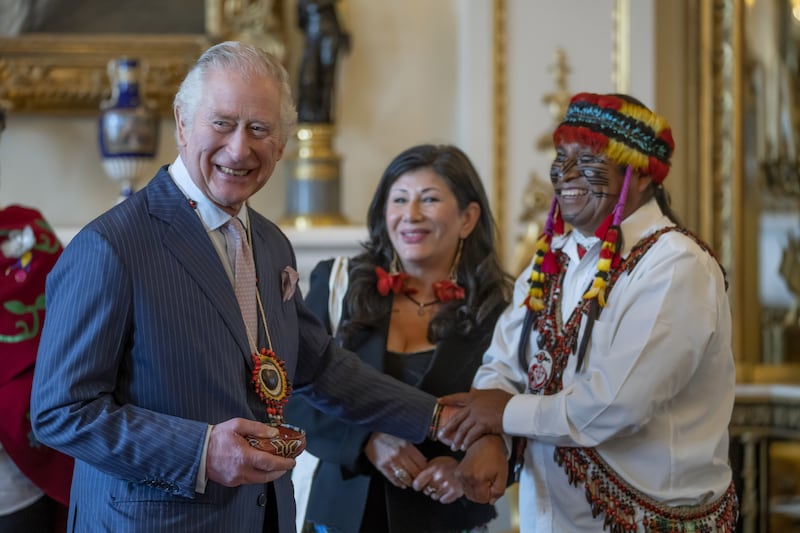The grand Hall of India and Pakistan in the Royal Overseas League clubhouse, not far from Buckingham Palace, was an apt venue for the unveiling to media of the first portrait of King Charles in advance of his coronation next month. The lesson in humility that followed was rather less expected.
The room was built with donations from Indian maharajahs in time to open for the 1937 coronation of George VI, grandfather of the current king. For curious citizens of next-door republics, he is better known as the monarch portrayed in the film The King’s Speech who conquered his stutter to address the nation.
All things imperial are firmly back on the agenda in London as George’s grandson prepares for his symbolic investiture. The British love a good ceremony and Charles has waited 74 years for his bit of pomp. Expect even Westminster’s political Punch & Judy show to quieten down a touch as the formalities approach. They will want to give him space.
The first portrait released of Charles as king was commissioned by Illustrated London News, a glossy publisher with its roots in the grand old British periodical of the same name, which became the world’s first pictorial magazine in 1842. Luminaries such as Rudyard Kipling and Agatha Christie used to write for the publication. It is British royalist in its DNA.
As the assembled foreign press waited for the king’s new portrait to arrive, it wouldn’t have been a surprise to some of us if the thing had been trumpeted into the hall. Republicans aren’t to know how these affairs are supposed to go. But it turned out more low-key and simpler than expected. Few noticed the portrait’s entrance. A young man skulked up the side of the room swinging by his side something wrapped in heavy paper. He quietly laid it down at the top of the room and unwrapped it slowly, like a fragile Christmas present. Then he slung it up on to an easel.
Portraits of kings and queens usually feature them in full regalia, robes swinging, sceptres blinging. This picture of Charles, however, was different. He was dressed relatively simply in a suit and pink tie, his left hand parked in his pocket. His face was interesting and warm but there were few adornments. This was just a man on a neutral background, looking with interest at something out of sight.
It turned out that the young man who had strolled in as if he was carrying home a newly-framed David Bowie poster was Alastair Barford, the first painter to capture the monarch. He was quietly spoken and shy. Suddenly the simple painting made sense, although apparently not to everybody.
One of the first questions fired Barford’s way came from an older journalist, a man who looked as if he had been around the establishment block. He rested on his knees a large, square, old-style briefcase, the sort of statement item you might expect from someone who understands status. His spoke with a French lilt but was from Belgium, a country with its own colonial past.
The older man did not speak unkindly or unfairly to Barford, but his scepticism towards the portrait was apparent. “Tell me what is regal about this picture,” he asked the young painter. The implication was clear: this is just a man in a suit. Didn’t you know you were painting a king?
“I don’t know,” replied Barford, with careful aplomb rather than a lack of assuredness. “I was more interested in creating a portrait of a man than a royal.” He said he wanted to capture what he saw as Charles’s empathy when he observed him. The king had met indigenous tribe leaders that day to talk about biodiversity. Barford followed him around for a few hours, observing his interactions and taking 600 photographs from which he later painted.
Charles did not sit for the portrait.

“Tell me what is regal about this picture.” Drop the final three words, and that becomes a much more interesting exhortation. Barford was more taken by how Charles interacted than by his title.
The painter was asked by another journalist if he was proud of the portrait.
“I don’t know that I have ever painted anything that I have been proud of,” replied Barford, who was also commissioned in 2015 to produce a portrait of Charles’ mother, the late Queen Elizabeth. “You view it through the hopes that you had for it [before it is painted]. You only see where it falls down.”
Charles, meanwhile, is up on May 6th. The royalist mood is building in Britain.

















